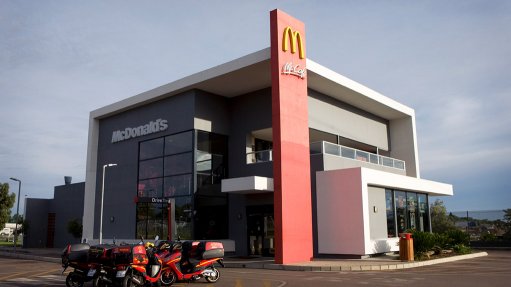
MCDONALD’S SILVERLAKES The light steel frame structures and conventional structures use energy efficient lights, equipment and design
The focus on small improvements in energy efficiency, restaurant interiors and client service, as well as the design and architecture of new restaurants, is helping global restaurant subsidiary McDonald’s South Africa to remain efficient, profitable and growing organically, says McDonald’s South Africa MD Greg Solomon.
The firm has installed energy efficient lights and equipment in its restaurants, and uses wind and solar energy systems – where appropriate – to reduce electricity use from the grid. Exterior cladding, shading structures and membranes in the restaurant ceilings appropriate for the local climates have also been used to reduce the energy used for air conditioning.
This concerted effort has enabled some restaurants to switch from 400 kVA to 250 kVA and energy savings technologies and initiatives will see more restaurants switching to 250 kVA. The group plans to reduce the average energy consumed by a further 50 kVA per restaurant, he says.
“Our franchisees are supportive of our groupwide efficiency initiatives. They recognise the need to maintain the strong brand image and save costs, but they also support us on the merits of these initiatives, as they ensure good customer experience and environment-conscious behaviour.”
The firm is building about 20% of its new buildings using light steel frame (LSF) techniques. Solomon notes that the cost of construction using LSF has increased to be on par with conventional construction methods.
LSF structures are up to 90% lighter than brick structures, resulting in less concrete being required for foundations, which also makes them more environment friendly. LSF construction methods also help to reduce weather-related delays, as the LSF structure and roof can be built allowing for wet and dry construction work to continue.
The company prefers to build restaurants on open stands, as this enables it to offer drive-through, which is a significant portion of its business, and it will continue its steady pace of adding 15 to 20 new restaurants a year. Four new restaurants will be opened before the end of this year, adds Solomon.
The focus on meeting the changing needs of customers has also boosted the company’s performance, he says, noting that 11.5% of the company’s revenues are derived from breakfast sales, while 5% are from 24-hour sales, and 74% of McDonald’s restaurants in South Africa provide 24-hour service.
The layout of the restaurants can be changed to provide appropriate seating, such as more tables during breakfast, and tables with more seating thereafter, he adds.
“The interior design and decor, as well as services, such as WiFi connectivity, are designed to fit the lifestyle choices of our customers. For example, our customers want to know where the food they eat comes from, and we provide the details of the origin and supply chain of foods and ingredients for them. “We aim to ensure that our restaurants meet the evolving needs and preferences of our customers in South Africa for the next 21 years.”